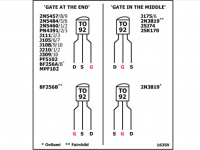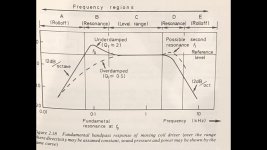thanks Mr Pass for the answer , what DSG mean 😱
.
Attachments
I believe Nelson Pass' post #370 dealt with this. The figure shows the tweeter 12 dB roll off and woofer 12 dB roll off, as HP and LP filters respectively.This is only the electric side of the crossover. In the real world, you need to use the acoustic respsonses of the drivers and adjust to suit.
To this the second order crossover network is shown. A simulation will show the response not to be flat when summing. I believe NP encouraged us to play with this.
You can explore the concept with a simulator, where the simplest model
of the output of a cone speaker has 12 dB/oct acoustic rolloff.
Try adjusting this simulation for a flat sum at woofer+tweeter nodes.
From Martin Colloms’ book “High performance loudspeakers” fourth edition. I guess I would like to locate my crossover frequency somewhere in the “C” range not using the natural roll off as part of the crossover. I also mean that if you stretch the woofers response up to the “C” it will become much more directive than the tweeter taking over. I am sure this gives abruptly off axis behavior.
Attachments
From Martin Colloms’ book “High performance loudspeakers” fourth
edition. I guess I would like to locate my crossover frequency somewhere in
the “C” range not using the natural roll off as part of the crossover.
Hard to avoid, since the phase variation of the driver extends well into
the C region.
And of course, like Monty Python's Camelot, "It's only a model."
 Crimson Permanent Assurance
Crimson Permanent AssuranceThat is a great one, ZM!
Those drivers! The phase! All that, perfection is impossible, but one can have different permutations of imperfection, I guess.
Those drivers! The phase! All that, perfection is impossible, but one can have different permutations of imperfection, I guess.
Thank you for making B4 available as a DIY project! Rubbing my hands, I can't wait to replace my Najda DSP crossover. I have prototyped the best all around crossover for my horn stack and I'm able to get away with no delays and a combination of 12 and 6db/oct filter slopes. Hooray -- I can go all analogue.
How many B4 kits will I need to replicate a 4-way stereo crossover? What will be the PS requirement for them?
thank you,
Herman
How many B4 kits will I need to replicate a 4-way stereo crossover? What will be the PS requirement for them?
thank you,
Herman
Quite often you can tweak the filters into a semblance of perfection.

Yes, your example has a "nice" 4 dB notch at 1 kHz. It should be possible to better it..................

Thank you for making B4 available as a DIY project!
We haven't done B4 yet. This one is like a dedicated B5.
If you only want 2 pole filters, it will work fine. The B4 extends to 3 and 4.
that is to say 18 and 24 dB/oct.
that is to say 18 and 24 dB/oct.
Yes, your example has a "nice" 4 dB notch at 1 kHz. It should be possible to better it..................
Indeed, you can probably get it within a dB without too much effort.
For my intended dedicated use all i really need is a buffered 1st order PLLXO. More poles would be nice for playing around.
dave
dave
For my application (basic 4-way crossover), 2 pole filters is enough. I use 6 and 12 db slopes. Can the bass boost of B5 be disabled?
- Home
- Amplifiers
- Pass Labs
- Pass Labs B4 crossover questions

